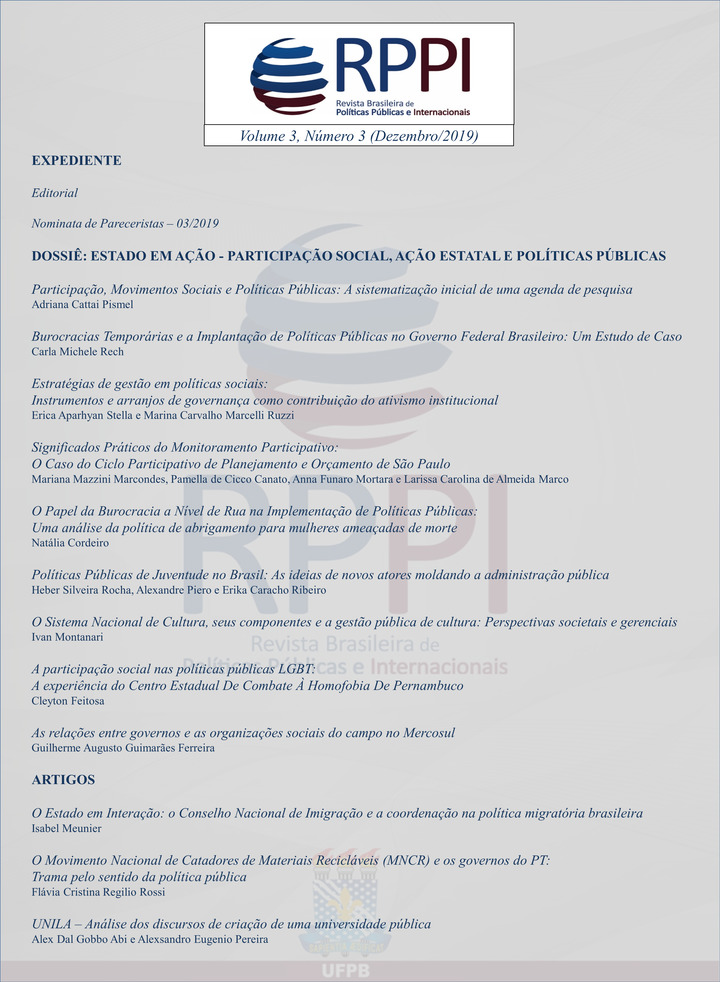The Interacting State
Brazilian National Immigration Council and the coordination in immigration policy
DOI:
https://doi.org/10.22478/ufpb.2525-5584.2019v4n3.47493Abstract
The National Immigration Council (CNIg) is a deliberative body made up of government representatives, employers, workers and civil society that carries attributions related to the formulation of national immigration policy. This article focuses on CNIg in order to: (i) analyze its historical trajectory, aiming to identify how the role played by the agency in the context of Brazilian migration policy evolved, and observe the strategies adopted to expand it or modify it; (ii) scrutinize how the pluralization of actors and the diversification of public policy processes affect the aggregation of preferences in shaping political output. For this purpose, we use the institutional framework, based on the concept of complex institutional arrangement, on the literature about intragovernmental coordination and on models of collective decision making.
Downloads
References
Alexander, E. (1993). Interorganizational Coordination: Theory and Practice. Journal of Planning Literature, 7(4), 328-343.
Allison, G. (1969). Conceptual Models and the Cuban Missile Crisis. The American Political Science Review, 63(3), 689-718.
Almeida, P.S. (2009) Conselho Nacional de Imigração (CNIg): Políticas de Imigração e Proteção ao Trabalhador Migrante ou Refugiado. Cadernos de Debates Refúgio, Migrações e Cidadania, 4 (4). Brasília : Instituto Migrações e Direitos Humanos.
Bouckaert, G.; Peters, G.; Verhoest, K.(2010). The Coordination of Public Sector Organizations: Shifting Patterns of Public Management. Hampshire: Pallgrave Macmillan.
Costa, B.; Bronzo, C. (2012). Intersetorialidade no enfrentamento da pobreza: o papel da implementação e da gestão. In: C. P. de Faria (Coord.). Implementação de políticas públicas: teoria e prática. Belo Horizonte: Ed. PUC Minas.
Evans, P. (1993). O Estado como Problema e Solução. Lua Nova, 28-29, abril 1993.
Fiani, R. (2014) Arranjos Institucionais e Desenvolvimento: o papel da coordenação em estruturas híbridas. In: A. Gomide; R. Pires (Coord.). Capacidades Estatais e Democracia: Arranjos Institucionais de Políticas Públicas. IPEA: Brasília.
Geddes, B. (1994). Politician’s Dilemma – Building state capacity in Latin America. Berkeley e Los Angeles: University of California Press.
Gomide, A.; Pires, R. (2014). Capacidades estatais e democracia: a abordagem dos arranjos institucionais para análise de políticas públicas. In: A. Gomide e R. Pires (Coord.) Capacidades Estatais e Democracia: Arranjos Institucionais de Políticas Públicas. IPEA: Brasília.
Hermann M. et al. (2001). Resolve, Accept, or Avoid: Effects of Group Conflict on Foreign Policy Decisions. International Studies Review, 3(2), “Leaders, Groups and Coalitions: Understanding the People and Processes in Foreign Policymaking”, 133-169.
Immergut, E. M.(1998). The Theoretical Core of the New Institutionalism. Politics & Society, 26(1), 5-34.
Jennings, E. Jr.; Krane, D. (1994). Coordination and welfare reform: the quest for the philosopher’s stone. Public Administration Review, 54(4), 341-348, jul/ago 1994.
Lupi, C. (2009) Introdução. In: P.S. Almeida; R. Penna (Coord.). OIT - Contribuições para a Construção de Políticas Públicas Voltadas à Migração para o Trabalho. Brasília: Escritório Internacional do Trabalho.
Peters, G. (1998). Managing horizontal government: the politics of coordination. Canadian Centre for Management Development, research paper nº 21. Disponível em: http://publications.gc.ca/collections/Collection/SC94-61-21-1998E.pdf. Acesso em: 15 dez 2016.
Regens, J. (1998). Institutional coordination of program action: a conceptual analysis. International Journal of Public Administration, 11(2), 135-154.
Thomson, A. M.; Perry, J. (2006). Collaboration Processes: Inside the Black Box. Public Administration Review, Special Issue: Articles on Collaborative Public Management, dez 2006.
Downloads
Published
Issue
Section
License
Autores que publicam nesta revista concordam com os seguintes termos:- Autores mantém os direitos autorais e concedem à revista o direito de primeira publicação, com o trabalho simultaneamente licenciado sob a Licença Creative Commons Attribution que permite o compartilhamento do trabalho com reconhecimento da autoria e publicação inicial nesta revista.
- Autores têm autorização para assumir contratos adicionais separadamente, para distribuição não-exclusiva da versão do trabalho publicada nesta revista (ex.: publicar em repositório institucional ou como capítulo de livro), com reconhecimento de autoria e publicação inicial nesta revista.
- Autores têm permissão e são estimulados a publicar e distribuir seu trabalho online (ex.: em repositórios institucionais ou na sua página pessoal) a qualquer ponto antes ou durante o processo editorial, já que isso pode gerar alterações produtivas, bem como aumentar o impacto e a citação do trabalho publicado (Veja O Efeito do Acesso Livre).




_.jpg)






.png)


.jpg)
_.png)
